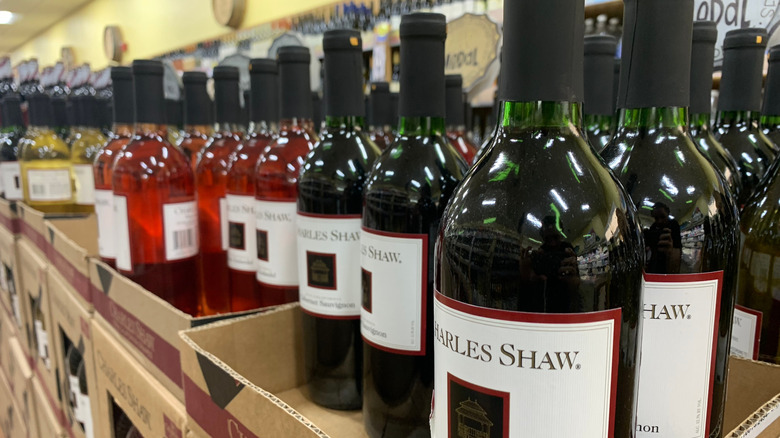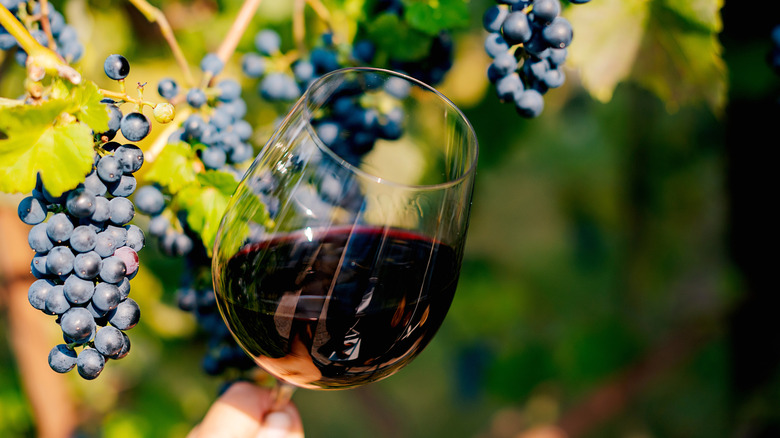How Trader Joe's Keeps Its Wine Priced So Low
You might be unfamiliar with Charles Shaw wine by name. But, more likely than not, you've had it served neatly in a paper cup at an office party or poetry reading. Or, perhaps you do know Charles Shaw; maybe it's your drink of choice, an economical wine to sip and enjoy at dinner. The Trader Joe's exclusive has become a staple in many Americans' lives. Devotees of the wine refer to it simply as Two-Buck Chuck, a reference to the wine's impossibly low price point. For years, the brand sold its various wines for $1.99 per bottle.
Now, of course, the price of Charles Shaw wine varies based on location. Still, this Trader Joe's wine only varies between $2 to $4 in price (don't worry – the grocer's other wines also carry a reasonable price tag). It's nothing if not a good deal. But, how has this wine remained so inexpensive? Rumors regarding the mysteriously low price point abound, with some concluding that the price was an act of revenge by the vintner Charles Shaw against his ex-wife in a divorce dispute. However, this is simply not true. The real reason behind the brand's low price point comes down to a few key factors, including automated production, less expensive materials, and cheap land. And, though the revenge explanation is not true, the invention of Two Buck Chuck does begin with a series of unfortunate events befalling Charles Shaw.
The history of Charles Shaw wine
Charles Shaw opened his first winery in 1974, fulfilling his long-held dream of making wine. In the early years, Shaw's winery produced higher-quality wine — in the '80s, the price was around $13.50 per bottle, significantly more expensive than its current price, and was highly awarded. However, Shaw's business hit a slump in the 1990s after some of its barrels of wine were ruined by use of the wrong wax. This, and a series of other financial blunders, put his business in turmoil. In 1995, the company was purchased by Fred Franzia (of Franzia boxed wines) for $27,000.
This severed Charles Shaw from his namesake wine. The dip in the price of Charles Shaw wine didn't happen until 2002, when there was an overflow of wine supply that coincided with a dip in demand due to the economic downturn following the September 11th attacks. This led the company to sell its wine at a loss, and the brand also began its partnership with Trader Joe's that year. However, this brief dip in the wine industry does not fully explain how Charles Shaw wine has been able to keep its prices so low for over two decades.
How Charles Shaw wine stays so cheap
How Charles Shaw maintains its low prices comes down to a few key business practices. For one, most of Charles Shaw's vineyards are located within the San Joaquin Valley, which generally has less expensive land prices due to its hot climate. This climate tends to shorten the grapes' growing season and may lead to spoiled grapes. Additionally, the wine is fermented in larger batches, allowing for more product to be produced at once. And, rather than aging its wine in wooden barrels, Charles Shaw wine is aged in wood chips. This lowers the cost of production. Probably the most important factor in Charles Shaw's low price is the company's use of automation in its production process. Rather than having workers harvest grapes from its vineyards, machines gather grapes and cut down on labor cost.
This process has been met with a fair deal of criticism, with many finding it unsanitary due to the possibility of plant and animal contamination. Of course, Franzia rebutted this critique. In a statement to CNBC, the company said, "If you worry about things like that, you shouldn't eat anything, you shouldn't drink anything. When the wine's fermenting, they're going to eliminate anything that's possibly there." So, just sip and rejoice that this one pleasure does not come at a sky-high cost.


